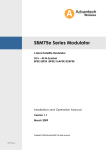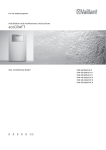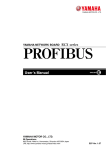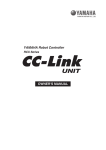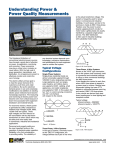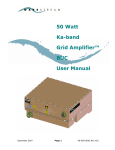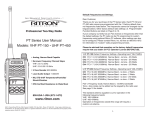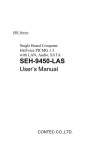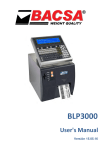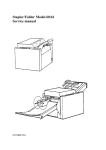Download Advantech SSPB-3000C Specifications
Transcript
INSTALLATION AND OPERATION MANUAL 200 WATT L-BAND TO C-BAND RACK-MOUNT SOLID STATE TRANSMITTER SSPB-3000C PM 150-50N415-6G0, Rev. 1 SSBP-3000C WARRANTY This ADVANTECH Advanced Microwave Technologies Inc. product is warranted against defects in material and workmanship for a period of 2 years from date of shipment. During the warranty period, ADVANTECH Advanced Microwave Technologies Inc. will, at its option, either repair or replace the product, which proves to be defective. To return a product for warranty or repair service, first request a Return Material Authorisation (RMA) number by contacting ADVANTECH at: Phone: (514) 420-0045 Website: www.AdvantechAMT.com or or Fax: (514) 420-0073 e-mail: [email protected] The product should be shipped to the following address, in the original shipping container (box), with the prepaid shipping charges. ADVANTECH Advanced Microwave Technologies Inc, 657 Orly Avenue Dorval, Quebec H9P 1G1 CANADA Please indicate the RMA number on all shipping documentation. Units shipped without a prior issued RMA, or not shipped in the original container, may be rejected and returned at sender’s expense. LIMITATIONS OF WARRANTY ADVANTECH Advanced Microwave Technologies Inc. warrants this product to be free of defects in materials and workmanship. The foregoing warranty shall not apply to defects resulting from improper handling or abuse by the purchaser, unauthorised modification, operating outside of the product’s environmental specifications, improper installation or maintenance. ADVANTECH Advanced Microwave Technologies Inc. shall not be liable for any direct, indirect, special, incidental or consequential damages. Page 1 SSBP-3000C CONTENTS 1. SAFETY.................................................................................................................................................................... 6 2. GENERAL INFORMATION ............................................................................................................................... 8 2.1 2.2 3. INTRODUCTION........................................................................................................................................................8 ABOUT THIS MANUAL.............................................................................................................................................8 MAJOR COMPONENTS AND THEIR FUNCTION..................................................................................... 10 3.1 L-BAND TO C-BAND UP-CONVERTER MODULE............................................................................................ 10 3.2 P OWER AMPLIFIER MODULE ................................................................................................................................ 10 3.3 WAVEGUIDE ARM ASSEMBLY............................................................................................................................... 11 3.4 10 MHZ OSCILLATOR ......................................................................................................................................... 11 3.5 MAIN CONTROLLER BOARD ................................................................................................................................. 11 3.5.1 Fault Detection and Indication ............................................................................................................ 12 3.5.2 MUTE Control ........................................................................................................................................ 12 3.6 P OWER SUPPLY SYSTEM....................................................................................................................................... 12 3.7 COOLING SYSTEM................................................................................................................................................. 13 3.8 FRONT P ANEL ...................................................................................................................................................... 13 3.9 ELECTRICAL SPECIFICATIONS ............................................................................................................................... 17 4. INTERFACES....................................................................................................................................................... 18 4.1 4.2 4.3 4.4 4.5 5. DISCRETE INTERFACE ........................................................................................................................................... 18 RS-232 INTERFACE ............................................................................................................................................. 19 RS-485 INTERFACE ............................................................................................................................................. 20 RF OUTPUT MONITOR INTERFACE ....................................................................................................................... 20 REDUNDANT INTERFACE ...................................................................................................................................... 20 UNPACKING AND INSTALLATION............................................................................................................... 22 5.1 INITIAL INSPECTION.............................................................................................................................................. 22 5.2 UNPACKING ......................................................................................................................................................... 22 5.3 INSTALLATION ..................................................................................................................................................... 22 5.3.1 Environmental and Adequate Ventilation Considerations.............................................................. 25 5.3.2 Mechanical Installation ........................................................................................................................ 25 5.3.3 Electrical Connections .......................................................................................................................... 26 5.3.4 RF Connections ...................................................................................................................................... 28 6. PRE-POWER AND SYSTEM CHECKOUT.................................................................................................... 29 6.1 6.2 7. P RE-POWER P ROCEDURES .................................................................................................................................... 29 OPERATIONAL SETTINGS VERIFICATION ............................................................................................................... 29 OPERATION......................................................................................................................................................... 30 7.1 INTRODUCTION..................................................................................................................................................... 30 7.2 SAFETY CONSIDERATIONS.................................................................................................................................... 30 7.3 BASIC OPERATING P ROCEDURE............................................................................................................................ 30 7.4 FRONT P ANEL OPERATION ................................................................................................................................... 31 7.5 DOWNLOADING THE SUPPLIED SOFTWARE ........................................................................................................... 32 7.6 USING THE SSPB SOFTWARE .............................................................................................................................. 34 7.6.1 Using the RS-232 Interface................................................................................................................... 34 8. MAINTENANCE .................................................................................................................................................. 40 Page 2 SSBP-3000C 8.1 8.2 8.3 9. P REVENTIVE MAINTENANCE................................................................................................................................. 40 MECHANICAL P REVENTIVE MAINTENANCE .......................................................................................................... 40 COOLING FAN CHECK........................................................................................................................................... 40 RS-485 SERIAL COMMUNICATION PROTOCOL .................................................................................... 41 9.1 FRAME STRUCTURE .............................................................................................................................................. 41 9.2 COMMANDS......................................................................................................................................................... 42 9.3 RESPONSE TO COMMANDS FROM SLA VE TO MASTER ........................................................................................... 43 9.3.1 Condition Status Response................................................................................................................... 43 9.3.2 Read Identification Response............................................................................................................... 43 9.3.3 Read Frequency Range Response........................................................................................................ 44 9.3.4 Read Frequency Set Response ............................................................................................................. 44 9.3.5 Unit Status and Position Response ..................................................................................................... 45 9.3.6 Read Frequency Shift Response........................................................................................................... 45 10. PACKING LIST.................................................................................................................................................... 46 11. APPENDIX A: SAFETY AND EMC COMPLIANCE.................................................................................... 48 Page 3 SSBP-3000C FIGURES FIGURE 1: PRODUCT OUTLINE.........................................................................................................9 FIGURE 2: SSPB BLOCK DIAGRAM ..............................................................................................14 FIGURE 3: FRONT PANEL ASSEMBLY ............................................................................................16 FIGURE 4: 1:1 REDUNDANT SYSTEM .............................................................................................21 FIGURE 5: CONNECTORS LOCATION ON FRONT AND BACK PANELS .............................................24 FIGURE 6: FRONT PANEL SEQUENCE ............................................................................................33 FIGURE 7: RS-232 COMMUNICATION VIA HYPERTERMINAL.........................................................35 FIGURE 8: HELP FUNCTION IN HYPERTERMINAL...........................................................................37 FIGURE 9: REDUNDANT SYSTEM (REAR VIEW) ..............................................................................49 FIGURE 10: REDUNDANT SYSTEM (LATERAL RIGHT VIEW).............................................................50 FIGURE 11: REDUNDANT SYSTEM (LATERAL LEFT VIEW)...............................................................51 FIGURE 12: REDUNDANT SYSTEM (TOP VIEW) ..............................................................................52 FIGURE 13: RS-232 COMMUNICATION VIA HYPERTERMINAL FOR REDUNDANT SYSTEM..............53 FIGURE 14: PROPOSED GRAPHIC USER INTERFACE FOR A REDUNDANT SYSTEM BASED ON RS-485 PACKET PROTOCOL ...............................................................................................................54 Page 4 SSBP-3000C TABLES TABLE 1: FRONT PANEL CONTROLS AND INDICATIONS ................................................15 TABLE 2: ELECTRICAL SPECIFICATIONS............................................................................17 TABLE 3: DISCRETE INTERFACE (J3) RELAY – PIN ASSIGNMENTS...............................19 TABLE 4: RS-232 SERIAL INTERFACE (J2) RS232 – PIN ASSIGNMENTS.........................19 TABLE 5: RS-485 SERIAL INTERFACE (J12) RS485 – PIN ASSIGNMENTS.......................20 TABLE 6: CONNECTORS .........................................................................................................23 TABLE 7: ENVIRONMENTAL CONDITIONS .........................................................................25 TABLE 8: SERIAL INTERFACE CONNECTION INFORMATION RS-232............................27 TABLE 9: POWER REQUIREMENTS.......................................................................................28 TABLE 10: AC LINE (J5) CONNECTOR – PIN ASSIGNMENTS............................................28 TABLE 11: RS-232 MENU ITEM DEFINITION........................................................................36 TABLE 12: COMPUTER TERMINAL COMMANDS FOR RS-232 INTERFACE ...................38 TABLE 13: COMMAND FRAME STRUCTURE.......................................................................42 TABLE 14: RESPONSE FRAME STRUCTURE........................................................................43 TABLE 15: READ IDENTIFICATION RESPONSE ..................................................................43 TABLE 16: READ FREQUENCY RANGE RESPONSE ...........................................................44 TABLE 17: READ FREQUENCY SET RESPONSE..................................................................44 TABLE 18: UNIT STATUS AND POSITION RESPONSE........................................................45 TABLE 19: READ FREQUENCY SHIFT RESPONSE..............................................................45 TABLE 20: PACKING LIST.......................................................................................................46 TABLE 21: REDUNDANCY KIT...............................................................................................47 Page 5 SSBP-3000C 1. SAFETY To prevent the risk of injury to personnel or loss related to equipment malfunction, ADVANTECH uses the following symbols throughout this document to indicate safety-related information. WARNING: This indicates a hazardous procedure that may result in serious injury or death ifCAUTION: not performed properly. This indicates a hazardous procedure that may result in light-to-severe injury or loss related to equipment malfunction, if proper precautions are not taken. For your own safety, read the following carefully BEFORE operating this equipment! ---------------------------------------------------- WARNING --------------------------------------------When supplying power to this equipment, verify that the power cable (not supplied) has the correct pin assignment as given by TABLE 10 at page 28. Connect the cable to a properly grounded 3-pin power outlet. Also connect a ground strap between the station’s ground bus and the ground screw on the vertical rack. If power is supplied without grounding the equipment, there is a risk of receiving a severe or fatal electric shock. In the context of this document any voltage that is lethal is viewed as ‘High Voltage’. The prime power potential of 180-264 VAC applied to the equipment is known to cause injury or death. --------------------------------------------------- WARNING ---------------------------------------------The operator cannot repair this equipment. DO NOT attempt to remove the transmitter cover or disassemble the internal components. Only qualified service technicians should service the transmitter. There are high-voltage parts within the unit, which present a risk of severe injury to the untrained personnel. In addition, there is a risk of damaging the delicate components. --------------------------------------------------- WARNING ---------------------------------------------ALWAYS TERMINATE THE RF OUTPUT WAVEGUIDE PORT OF THE TRANSMITTER WITH A RF LOAD CAPABLE OF DISSIPATING FULL CW RF POWER. ALSO, TERMINATE THE IF INPUT CONNECTOR TO AVOID THE POSSIBILITY OF THE UNIT BEING DRIVEN BY STRAY LEAKAGE SIGNALS. Page 6 SSBP-3000C Incorporate the terminations prior to applying prime power to the transmitter. This procedure prevents self-oscillation and irradiation from and into the local environment. If the IF input of the transmitter is not connected to a RF source, the unit may go into a self-induced mode and generate high levels of RF energy. Destruction caused by an excessive load voltage standing wave ratio (VSWR) will void the warranty. --------------------------------------------------- WARNING ---------------------------------------------DO NOT LOOK INTO THE RF OUTPUT PORT OF THE POWERED TRANSMITTER! Handle the unit with extreme care. Although the levels of microwave radiation do not induce immediate physical discomfort in most individuals, the levels may be sufficiently high to induce long-term effects. The eyes are the most vulnerable parts of the body. The maximum permissible levels of RF exposure are quite low compared to the power levels emitted by the transmitters built by Advantech (e.g. less than 10 mW versus 10 to 500 W for the units). The maximum permissible levels are currently being studied by a number of organisations. In the past, the U.S. Safety Code established a dosage rate of 10 mW/cm2. Currently, consideration is being given to reduce the permissible level to 1 mW/cm2 in the United States, as has been the case for several European countries. ---------------------------------------------------- CAUTION ---------------------------------------------THE TRANSMITTER UNIT IS HEAVY! TWO INDIVIDUALS OR A LIFTING DEVICE MUST BE USED TO LIFT AND MOVE THE UNIT. There is a risk of back injury, if carried or lifted by a single person. In addition to this Section, included by reference are the following pertinent sections of the International Standard IEC-215, ‘Safety requirements for radio transmitting equipment’: Appendix D, ‘GUIDANCE ON ASSESSING THE COMPETENCE OF PERSONNEL FOR DESIGNATION AS SKILLED’ and also Sub-clause 3.1 of the Standard. Appendix E, ‘GUIDANCE ON SAFETY PRECAUTIONS TO BE OBSERVED BY PERSONNEL WORKING ON RADIO TRANSMITTING EQUIPMENT’ and also Sub-clauses 3.2, 3.7 and 22.1 of the Standard. Page 7 SSBP-3000C 2. GENERAL INFORMATION 2.1 INTRODUCTION The ARMU-LC200-BRN , part of the SSPB-3000C family, is a 200-Watt L-Band to C-Band Solid State Up-Converter (SSPB) designed for satellite up-link communication systems. The SSPB is an indoor unit conceived for mounting into a standard 19-inch rack. The RF output should be connected to an antenna using a waveguide system. The product outline of the unit is shown in Figure 1 at page 9. Built-in monitor and control features indicate the current status of the SSPB unit and provide fault detection and protection when operating outside normal operating conditions. The SSPB also allows the user access to the monitor and control functions by using the Relay (Discrete) Interface, or the RS-232 and the RS-485 Serial Interfaces. The SSPB unit can be combined with another unit to form a 1:1 redundant system (see Figure 4 at page 21). A redundancy kit is available as an option to build a 1:1 redundant system. 2.2 ABOUT THIS MANUAL This manual contains information that describes the installation, operation and maintenance procedures for the 200-Watt C-Band rack-mount SSPB Up-Converter. Warnings appear at the appropriate points to caution all users of the potential RF and high-voltage hazards. For a safe and versatile operation, please read carefully all of the information provided by this manual BEFORE using this equipment! ADVANTECH Advanced Microwave Technologies, Inc. has prepared this manual for use as a guide for the proper installation, operation and maintenance of the ADVANTECH Solid State High Power Up-Converters. The drawings, specifications and information contained herein are the property of ADVANTECH Advanced Microwave Technologies, Inc. Unauthorised use or disclosure of these drawings, specifications and information is strictly prohibited. These documents shall not be reproduced, copied or used in whole or in part as the basis for manufacturing or sale of the equipment or software programs without the prior written consent of ADVANTECH Advanced Microwave Technologies, Inc. Page 8 SSBP-3000C Figure 1: Product Outline Page 9 SSBP-3000C 3. MAJOR COMPONENTS AND THEIR FUNCTION This Section describes the major components and their functions within the SSPB unit. The SSPB incorporates an L-Band to C-Band Up-Converter module, a Power Amplifier module, a Waveguide Arm assembly, a 10 MHz oscillator, a Main Controller board, a Power supply subsystem, a Current Sensor, a Cooling system and a Front Panel assembly. The remote monitoring and control of all major parameters is possible via the RS-232 and RS-485 interfaces. 3.1 L-BAND TO C-BAND UP-CONVERTER MODULE The L/C-Band Up-Converter Module converts and amplifies the incoming L-Band signals into the desired C-Band carrier signals. The module has an internal synthesiser, which is fixed at 4900 MHz. To control the output power level of the converter, an attenuator is used to provide the system gain control. The Up-Converter module has RS-485 communication to the Main Controller board. An additional discrete signal is available at this module: the Alarm Up-Converter (output). 3.2 POWER AMPLIFIER MODULE The Power Amplifier Module amplifies the RF C-Band signals from the L/C-Band Up-Converter module over the frequency range of 5.850 GHz to 6.425 GHz. The power amplifier has a 60 dB typical gain. For monitoring, the power amplifier has an RS-485 interface, which connects to the main controller board. Two additional discrete signals are available at this module: the Alarm PA (output) and the Mute PA (input) for muting the Power Amplifier. A temperature sensor is installed at the hot spot of the module to monitor the temperature. When the hot spot temperature exceeds +85 ºC, a shutdown command is issued by the controller of the module, in order to prevent the damage of the RF devices due to overheating. The controller of the Power Amplifier also has the following functions: 1. Provides and removes the DC voltages to the GaAs FET devices within the module. 2. Sends a FAULT signal to the main controller board when detecting a fault. The Power Amplifier will be in Mute mode if: 1. The Main Controller board sends a MUTE command to the PA module. 2. The hotspot temperature exceeds 85°C, Page 10 SSBP-3000C 3. Any of the GaAs FET devices fails (current is out of range) 3.3 WAVEGUIDE ARM ASSEMBLY The Waveguide Arm Assembly contains a forward power detector, a reverse power detector, a RF isolator, an output power coupler, and a waveguide band-pass filter. The forward power detector and the reverse power detector monitor the RF output power and the reflected power level and sends these detected signals to a Digital Power Monitor module, that converts these analogue signals into digital ones. The digital signals are sent to the Main Controller board via an RS-485 serial interface. The RF isolator provides VSWR protection at the SSPB RF output port. The VSWR at the isolator output is 1.25:1, minimum. The termination load of the isolator is capable of absorbing full reflective power. A CPR-137 grooved waveguide flange is the output of the unit. 3.4 10 MHZ OSCILLATOR This circuit is used to generate a 10 MHz reference signal with a high stability of 3 x 10-8 typical, which is required by the Up-Converter module. The 10 MHz signal is provided to the UpConverter module via a coaxial cable. 3.5 MAIN CONTROLLER BOARD The Main Controller Board contains a microprocessor controller that performs all of monitoring and the control, input/output communication and the decision-making. The main controller board provides: 1. Fault detection and indication from each part of the unit 2. Mute control and indication 3. Forward RF power detection and indication 4. Reflected power detection and indication 5. Power On indication (front panel LED) 6. Redundancy control (1:1 redundant system) 7. Frequency control 8. Unit gain control (attenuation setting). 9. Discrete Interface, RS-232 and RS-485 Serial Interfaces Page 11 SSBP-3000C 3.5.1 FAULT DETECTION AND INDICATION The unit will automatically go into a shutdown mode and send a message to all of the external interfaces when any one of the following occurs: 1. The local oscillator within an up-converter module is out of lock. 2. The hotspot temperature exceeds 85°C. 3. Any of the GaAs FET devices fails. The SSPB continually monitors the internal temperature and the current consumption. It also has an automatic shutdown feature to prevent operation at excessive temperatures. The unit will automatically restart when the hotspot temperature falls below 65°C. A thermal alarm may result from any one of the following conditions: 1. High ambient temperature (SSPB is designed to operate between 0°C and + 50 °C ambient). 2. Blockage at the air intake or exhaust vents. 3.5.2 MUTE CONTROL The user can disable the RF output power remotely by: 1. Leaving unconnected pins 1 and 5 of the RELAY Interface connector. 2. Sending a mute command in terminal mode through the RS-232 interface. 3. Sending a mute command in packet mode through the RS-485 interface. This feature is useful if the user wishes to perform a maintenance check or to check out the transmission system. 3.6 POWER SUPPLY SYSTEM The Power Supply System has one input: 180-264 VAC. The power supply provides a +12 VDC high current output to the following modules via relay K1 and the ON/OFF switch (see Figure 2 at page 14): 1. Power amplifier module, 2. L/C-Band up-converter module, 3. Secondary power supply, 4. Varifan power supply, 5. 10 MHz oscillator, 6. Redundancy waveguide switch, (if working in the redundancy mode) and Page 12 SSBP-3000C 7. Current sensor. The main controller board also receives the +12 VDC low current from the power supply. The main power supply operates from an 180 - 264 VAC, 47-63 Hz power source. The secondary power supply provides multiple outputs for operating the L-Band/C-Band upconverter and the power amplifier modules. To prevent unwanted noise from entering the SSPB, a line filter is connected between the AC input connector and the main power supply. The overall typical power consumption, at the rated RF output power, is approximately 400 Watts. 3.7 COOLING SYSTEM The cooling system for the SSPB consists of four cooling fans. Two fans are mounted at the front panel and the other two at the rear panel (see Figure 1 at page 9). The Varifan power supplies provide + 48 VDC voltages (variable between 11 and 60 VDC, temperature dependent voltages) for operating the four cooling fans. The Varifan power supplies are configured for +12 VDC input voltage operation. 3.8 FRONT PANEL The front panel provides for the user, LOCAL monitoring and control of the SSPB. The front panel contains an ON/OFF circuit breaker, six pushbuttons, six LEDs and a vacuum florescent display (VFD). TABLE 1 at page 15 lists and describes the front panel controls and indications. Figure 3 at page 16 shows the front panel outline. Page 13 REF AMP GND RS-485_UC ALARM_UC GND N GND TH +12 V N + 12 V +12 V CURRENT SENSOR GND MAIN POWER SUPPLY -9V +12 V +12 V CS CLEAR +5V DOWN LEFT UP RIGHT RS-485_UC FRONT PANEL BUTTONS GND FRONT PANEL DISPLAY FRONT PANEL PCB BPF REFLECTED POWER DETECTOR DIGITAL POWER MONITOR OUTPUT POWER DETECTOR 30 dB 40 dB RS-232 RELAY RS-485 REDUND W/G ARM ASSEMBLY CIRCULATOR MAIN CONTROLLER BOARD RS-485_PA L +12 V SECONDARY POWER SUPPLY TEMP SENSOR ALM_PA VARIFAN POWER SUPPLY 50 50 50 10 MHz OUT +12V, -9V HPA CONTROLLER & POWER CONDITIONER BOARD +12V, -9V LNA oC ALARM_UC L 48 V (0 ... 64 V) 10 MHz TH ISOLATOR THERMISTOR MUTE_PA CIRCUIT BREAKER -9 V +12 V ENTER N BPF +12 V 10 MHz REFERENCE SPLITTER OSCILLATOR PLL LO MIXER HPA ASSEMBLY FW_PWR RS-485_PM G COOLING FANS (4) CONTROLLER AMP VVA L-BAND TO C-BAND UP-CONVERTER RV_PWR L J5 AC LINE J1 RF IN RS-232 RELAY RS-485 REDUND RF_OUT MON SSBP-3000C +12 V -9V +12 V Figure 2: SSPB Block Diagram Page 14 SSBP-3000C TABLE 1: FRONT PANEL CONTROLS AND INDICATIONS Control/display Function CLEAR Select menu line, select item for modification or end of item’s modification, save new value or return to previous item. Return to previous item without saving any value. UP arrow Move to previous menu item or modify selected parameter. DOWN arrow Move to next menu item or modify selected parameter. LEFT arrow Select character left from the cursor for modification. RIGHT arrow Select character right from the cursor for modification. ENTER PWR ON LED RF ON LED REDUNDANT LEDs STATUS LEDs REMOTE MUTE LED ALARM LED FAULT LED AUTO LED ONLINE LED STBY LED Vacuum Fluorescent Display (VFD) Blue LED. When lit, indicates that power is applied to the Main Controller Board of the unit. Green LED. When lit, indicates that the unit is in RF ON (NOT MUTE) state. Green LED. When lit, indicates that the unit is in REMOTE CONTROL (from PC) as opposed to LOCAL control (from its front panel). This situation is not applicable for these units which do not discriminate between LOCAL and REMOTE control. Consequently this LED will be always dark. Yellow LED. When lit, indicates that the RF circuits are disabled and no RF output power is delivered. Yellow LED. When lit, indicates a temperature ALARM situation: the hot spot temperature of the unit is over 75 °C but under 80 °C. The unit is still functional but with some degraded performance. Red LED. When lit, indicates the failure of the unit. The unit is not functional. Blue LED. When lit, indicates that the redundancy control is in AUTO mode (if the ON-LINE unit failed, the switching of the STAND-BY unit to the antenna is performed automatically). Green LED. When lit, indicates that the unit is in ONLINE (switched to the antenna) in the redundant configuration. Yellow LED. When lit, indicates that the unit is in STAND-By (switched to the dummy load) in the redundant configuration. Displays 2 lines of 20 alphanumerical characters. The first line shows the output power level of the SSPB and the gain. The second line shows the selected menu type or the value of the selected parameter. Figure 6 at page 33 shows all of the menus used by the SSPB. Page 15 SSBP-3000C Figure 3: Front Panel Assembly Page 16 SSBP-3000C 3.9 ELECTRICAL SPECIFICATIONS The electrical specifications for the SSPB are listed in TABLE 2. TABLE 2: ELECTRICAL SPECIFICATIONS Input Frequency 950 - 1525 MHz L-Band Input Impedance 50 Ω Input VSWR ≤ 1.5 : 1 Linear Gain 73 dB ± 1 dB, @ 6.150 GHz and +23 °C L-Band Input Operational Level -21 … -11 dBm Frequency Stability 3 x 10–8, typical RF Output Power 1 dB Compression (P1dB) + 52 dBm, min Third Order Intermodulation ≤ -26 dBc (2 equal tones, 5 MHz apart, each at -6 dB output back-off from P1dB ≤ -36 dBc (2 equal tones, 5 MHz apart, each at -10 dB output back-off from P1dB RF Output Frequency Range 5.850 - 6.425 GHz (C - Band) Spurious at P1dB In-band Out-of-band ≤ 1.25 : 1 RF Output VSWR Gain Flatness: Over 2 MHz -50 dBc, max -50 dBc, max Over 36 MHz 2 dB, p-p, max 0.5 dB, p-p, max Gain Variation Over Temperature 2 dB, p-p Phase Noise Offset 100 Hz 1 kHz 10 kHz ≥ 100 kHz C-Band Single Side Band Phase Noise -60 dBc/Hz -70 dBc/Hz -80 dBc/Hz -90 dBc/Hz Operating Temperature 0oC to 50 oC Page 17 SSBP-3000C 4. INTERFACES The SSPB provides four user interfaces that could be used to connect to several optional external devices. The interfaces for this model are listed below: 1. Discrete Interface (J3): This interface offers the essential monitoring and control of the SSPB by discrete signals. 2. RS-232 Interface: This interface offers to the operator the essential monitoring and control of the SSPB using a personal computer equipped with any terminal software. 3. RS-485 Interface: This interface offers the complete monitoring and control of the SSPB and provides the communication and remote control through the RS-485 serial communication port in packet mode. 4. RF Output Monitor Interface: This interface provides a sample of the output power of the unit through a 40-dB coupler. 4.1 DISCRETE INTERFACE The Discrete Interface is located at connector (J3) on the rear panel of the SSPB (see Figure 5 at page 24). This connector is a female, 15-pin DB-type with a pin assignment as shown in TABLE 3 at page 19. Pins 2, 3 and 4 of connector (J3) are of Form-A relay type outputs that provide the user an indication informing the status of the SSPB. Pin 1 of connector (J3) RELAY is the mute control input, allowing the user to mute or un-mute the RF output of the SSPB. CAUTION: If pin 1 is not connected to pin 5, the unit will remain disabled (mute). Page 18 SSBP-3000C TABLE 3: DISCRETE INTERFACE (J3) RELAY – PIN ASSIGNMENTS Pin Description TX_MUTE (External MUTE Command) If pin 1 (MUTE COMMAND) is connected to pin 5 (MUTE COMMON) the SSPB is enabled (RF ON). If pin 1 (MUTE COMMAND) is not connected to pin 5 (MUTE_COMMON) the unit is disabled (MUTE). TX_AL_NC (FAULT-NC) Normal closed contact of TX_ALARM (FAULT) Relay. If closed to pin 2 (TX_AL_COM) indicates the FAULT state of the unit. TX_AL_COM (FAULT-COM) FAULT relay common TX_AL_ NO (FAULT-NO) Normal open contact of TX_ALARM (FAULT) Relay. If open relative to pin 2 (TX_AL_COM) indicates the FAULT state of the unit. MUTE_COMMON (common) 1 2 3 4 5 6-9 N/C (not connected) 4.2 RS-232 INTERFACE This serial communication interface offers to the operator the essential monitoring and control of the SSPB using any PC terminal software. An IBM compatible personal computer can be connected to this port. This interface is located on the back panel of the SSPB (see Figure 5 at page 24). The mounting connector is a female, 9-pin DB-type with a pin assignment as shown in TABLE 4. TABLE 4: RS-232 SERIAL INTERFACE (J2) RS232 – PIN ASSIGNMENTS Name Type Pin # Designation - - 1, 9 Not used TX-232 Serial port (output) 2 Serial transmit TX RX-232 Serial port (input) 3 Serial receive RX RS-232_C Serial port (common) 5 System common - Jumper 4 to 6 - - Jumper 7 to 8 - Page 19 SSBP-3000C 4.3 RS-485 INTERFACE This serial communication interface provides for the user, access to all of the monitor and control functions for the SSPB. The RS-485 interface in a redundant system must be connected to the NMS. The NMS will have access to both units. The RS-485 interface is located at connector (RS485) on the rear panel of the SSPB. The mounting connector is a female, 9-pin DB-type with a pin assignment as shown in TABLE 5. If this interface is being used, an interconnecting cable with the proper mating connector must be fabricated. TABLE 6 at page 23 provides the correct type of mating connector for the interface. TABLE 5: RS-485 SERIAL INTERFACE (J12) RS485 – PIN ASSIGNMENTS Pin # 1,2,7,8 3 4 5 6 9 Name RXTXCommon TX+ RX+ Type Not used Serial port (input return) Serial port (output return) Serial port (common) Serial port (output) Serial port (input) Active condition Serial receive RXSerial transmit TXSystem common Serial transmit TX+ Serial receive RX+ 4.4 RF OUTPUT MONITOR INTERFACE This RF output sample port is located at the (OUTPUT MONITOR) connector, which is mounted on the front panel of the SSPB (see Figure 5 at page 24). This interface is used for the independent monitoring of the SSPB output signal. 4.5 REDUNDANT INTERFACE The Redundant Interface connections are made with a female 15-pin DB-type connector (J6-1) and a female 9-pin DB-type connector (J6-2) of each SSPB. For a standalone unit, this interface is not used. The interconnections for a 1:1 redundant system are shown in Figure 4 at page 21. Note that in a redundant system, the Monitor and Control and the Display on the Front Panel of a unit are supplied with DC power from both its own power supply and the second unit power supply. So the Display on the Front Panel is on (and the buttons are active), even if the unit is powered off (as long as the second unit is powered). Page 20 SSBP-3000C RS-232 TO PC UNIT "A" J1 J7 RF OUT TRANSMITTER RF INPUT A J6-1 J6-2 W/G A W/G LOAD WAVEGUIDE SWITCH TO ANTENNA SPLITTER REDUNDANT I/F CABLE IF INPUT (TYPE N, FEMALE) B J6-2 To NMS W/G J6-1 RS-485 J1 J7 TRANSMITTER RF OUT RF INPUT B RS-232 UNIT "B" TO PC Figure 4: 1:1 Redundant System Page 21 SSBP-3000C 5. UNPACKING AND INSTALLATION This Section contains instructions for the site preparation, unpacking and installation of the SSPB. 5.1 INITIAL INSPECTION Inspect the shipping container for damage resulting from the shipment. If damaged, immediately contact the carrier that delivered the equipment and submit a damage report. Failure to do so may invalidate future claims. 5.2 UNPACKING Carefully remove all of the items from the shipping container. Save all of the packing material until completing successfully the visual inspection. Verify that all of the items listed on the packing list (see TABLE 20 at page 46) have been received. If any of the items are missing, immediately contact ADVANTECH. Inspect all of the items for evidence of damage resulting from the shipment. If damage seems evident, immediately contact the carrier that delivered the equipment and file a claim. Failure to do so may invalidate future claims. Check the unit thoroughly for damaged or loose parts. 5.3 INSTALLATION Installation of the SSPB requires the following four phases: Environmental and adequate ventilation considerations Mechanical installation Electrical connections RF connections TABLE 6 at page 23 lists all connectors used by the SSPB unit and their corresponding mating connectors. Figure 5 at page 24 shows the location of the connectors. Page 22 SSBP-3000C TABLE 6: CONNECTORS Connector Function Description Mating Connector (J1) RF IN L-Band Input N-Type (F) N-Type (M) (J2) RS232 RS-232 Serial Interface DB-9S (F) DB-9P (M) (J3) RELAY Discrete Interface DB-9S (F) DB-9P (M) OUTPUT MONITOR RF Output Monitor N-Type (F) N-Type (M) (J5) AC Line IEC-320 (M) IEC-320 (F) (J6) Redundant Interface DA - 25S (female) DA - 25P (male) (J7) Waveguide Output CPR–137 (Grooved) CPR–137 (Flat) (J12) RS485 RS-485 Serial Interface DB - 9S (F) DB - 9P (M) Page 23 SSBP-3000C Figure 5: Connectors Location on Front and Back Panels Page 24 SSBP-3000C 5.3.1 ENVIRONMENTAL AND ADEQUATE VENTILATION CONSIDERATIONS The SSPB contains a forced air cooling system, which prevents the internal components from overheating and to optimise performance stability. The cooling system consists of three fans to effectively distribute and remove the air from within the unit. Prior to installing the SSPB, verify that: 1. Environmental conditions listed in TABLE 7 will be met. 2. A minimum clearance of 30-cm (12 inches) is necessary in front of the air intake openings on the rear panel. 3. The grill of the fan intake and the exhaust openings of each AWTX are free of any obstructing debris. CAUTION: Obstructing objects or debris may reduce the efficiency of the cooling system and significantly impact uponon the longevity of the SSPB. TABLE 7: ENVIRONMENTAL CONDITIONS Temperature: Non-operating (continuous exposure) Operating (ambient) -40 °C to + 55 °C 0 °C to + 50 °C Relative Humidity: Up to 90% relative humidity, non-condensing Altitude: 10,000 feet AMSL, de-rated 2°C/1,000 feet from AMSL 5.3.2 MECHANICAL INSTALLATION 5.3.2.1 Mounting Considerations For a proper installation, the SSPB requires a standard 19-inch equipment rack and must be secured by the front panel. Prior to installing the SSPB ensure that at least two individuals lift and position the unit on to the equipment rack. 5.3.2.2 Installation Procedure Install the SSPB into the 19-inch rack as follows: Page 25 SSBP-3000C 1. Using the proper mounting hardware and the non-pivoting slide kit (see TABLE 20 at page 46), install the SSPB on to the rack with the waveguide output facing the rear. 2. For a pressurised waveguide system install a pressure window at the RF output port of the SSPB. 3. Attach a waveguide gasket (see TABLE 20 at page 46) on to the groove of the interconnecting waveguide system flange. 4. Position the interconnecting waveguide system flange so that it aligns precisely with the waveguide flange of the RF output port (J7). 5. After alignment verification, loosely attach the interconnecting waveguide on to the RF output port using four #10-32 x 1/2 inch screws and four #10 lock washers (see TABLE 20 at page 46). Finger-tight all screws. 6. Tighten all screws around the RF output port using a ‘star’ pattern to achieve uniform contact across the entire surface of the flange. CAUTION: Over-tightening the bolts may cause the stripping of the threads or distort the mating flange. 5.3.3 ELECTRICAL CONNECTIONS The connector locations referred to in this Section are shown in Figure 5 at page 24. The electrical interconnections for the stand-alone unit consist of the Discrete Interface, RS-485 Serial Interface, RS-232 Serial Interface and the AC power. 5.3.3.1 Discrete Interface If it is desired to use this interface, then construct an interconnecting cable by using the proper mating connector as described in TABLE 6 at page 23 and with the correct pin assignment as listed in TABLE 3 at page 19. Attach the interconnecting cable with connector to port (J3) of the SSPB and the user’s monitor and control system. NOTE: Whether this interface is being used or not, it is necessary to connect pin 1 of connector (J3) RELAY to pin 5 in order to enable (un-mute) the unit. If pins 14 and 5 of this interface are not connected together, the unit will remain muted. 5.3.3.2 RS-485 Interface If it is desired to use this interface, then construct the interconnecting cable by using the proper mating connector as described in TABLE 6 at page 23 and with the correct pin assignment as shown in TABLE 5 at page 20. Connect the free end of the interconnecting cable to the operator’s monitor and control system. If remote control through this interface is unnecessary, leave the port disconnected. Page 26 SSBP-3000C 5.3.3.3 RS-232 Interface 1. If it is desired to use the RS-232 terminal mode, then construct an interconnecting cable by using the proper mating connector as described in TABLE 6 at page 23 and with the correct pin assignment as listed in TABLE 4 at page 19. 2. Attach to the free end of the interconnecting cable a 9-pin or 25-pin D-type connector with a pin assignment as listed in TABLE 8 at page 27. 3. Attach the cable with the 9-pin or 25-pin D-type connector to RS-232 port of the personal computer. TABLE 8: SERIAL INTERFACE CONNECTION INFORMATION RS-232 RS-232 at PC Pin # DB-9 DB-25 Serial Interface Pin # Signal Direction 2 RX ç 3 2 3 TX è 2 3 5 common 5 7 5.3.3.4 AC Power and Ground 1. Attach a ground cable to the ground stud provided on the rear panel (see Figure 5 at page 24). 2. Connect the remaining end of the ground cable to the 19-inch rack. 3. Use a ground cable to ground the 19-inch rack to the power station’s ground bus. 4. For AC interconnection perform the following: a. Verify that the AC power source can satisfy the power requirements as given by TABLE 9 at page 28. b. Verify that the AC power source is switched OFF. WARNING: Proper grounding of the AC power outlet is necessary for personnel and equipment safety. Improper grounding may cause serious injury or death to the operator. c. Construct an AC power cable with connector having the correct pin assignment as shown in TABLE 10 at page 28. Page 27 SSBP-3000C CAUTION: Ensure that the proper pin is selected for AC operation. Applying power on the wrong pin may permanently damage the SSPB, necessitating factory repair. d. Connect the AC power cable to AC Line port of the SSPB and the AC power source. TABLE 9: POWER REQUIREMENTS Power Requirements Power Consumption 180 - 264 VAC, 47-63 Hz, single phase 8 A typical @ 230 VAC TABLE 10: AC LINE (J5) CONNECTOR – PIN ASSIGNMENTS 5.3.4 Pin Description A PHASE (LIVE) B GROUND C NEUTRAL RF CONNECTIONS CAUTION: Beware of the destructive pin depth of the mating connector. When installing an RF mating connector with a destructive pin depth into an RF component connector, damage may occur to the RF component connector. A destructive pin depth is a connector having a pin length that is too long in respect to the reference plane of the connector. The centre pins of the connectors used by ADVANTECH have a precision tolerance measured in mils (1/1000 inch). The mating connectors of the various suppliers may not be of precision types. Consequently, the centre pins of these devices may not have the proper depth. 1. Attach the interconnecting cable with a N-type male connector from the RF source on to the LBand IN connector (J1) located on the rear panel (see Figure 5 at page 24). 2. If necessary, connect a power meter or a spectral analyser to the RF output monitor port located on the front panel (see Figure 5 at page 24). Page 28 SSBP-3000C 6. PRE-POWER AND SYSTEM CHECKOUT This Section describes the pre-power procedure for the SSPB and an initial checkout of the system. WARNING: The information presented in this Section is addressed to technicians having specific training in and knowledge of Microwave Power Transmitters. Inappropriate use of the SSPB may cause serious injury to the operator or result in damage to the unit. Do not attempt to operate the SSPB before becoming thoroughly familiar with the contents outlined in this Section. 6.1 PRE-POWER PROCEDURES Before applying power to the SSPB, verify that the following conditions are met: 1. The voltage of the station’s AC prime power matches with the value marked on the ID label. It is 180-264 VAC for this unit. 2. The prime power station is properly grounded. 4. All cable and waveguide connections are secure and there is no evidence of pinched wires and loose hardware. 5. The circuit breaker at the prime power station is switched OFF. 6. The L-Band input and RF output ports are connected to a matched source and a proper load capable to withstand full CW RF power. 7. The cooling fans are not obstructed. CAUTION: Failure to verify these pre-power conditions may damage the SSPB or cause a malfunction. Operating the SSPB before verification may void the warranty. 6.2 OPERATIONAL SETTINGS VERIFICATION The SSPB arrives with all of its factory-pre-set operational values that meet the requirements of a typical installation. Before starting the unit at the installation site, check the configurable settings and if necessary, reset to meet the customer’s requirements. Page 29 SSBP-3000C 7. OPERATION 7.1 INTRODUCTION This Section describes the normal operation of the SSPB in a stand-alone configuration. The design of this equipment allows for minimal operator intervention and maintenance. The SSPB may be monitored and controlled via the RS-232 or RS-485 Serial Interfaces, Discrete Interface or from the front panel controls and display. The Discrete Interface provides for the user an alarm indication and remote RF mute capability. The RS-232 and the RS-485 Serial Interfaces and the front panel controls and display provide access to the unit’s functions including system monitoring of key operating parameters, control of gain, frequency and shutdown (mute). A software communication program is provided with the SSPB allowing full access to the unit’s functions. For front panel operation refer to Figure 6 at page 33. 7.2 SAFETY CONSIDERATIONS WARNING: Prolonged operation without a load at the output may cause severe bodily harm, loss of sight and even death. Do not operate the SSPB if the RF output connector is not connected to a proper load. Please note that an SSPB failure due to the above condition will be attributed to abuse or neglect and will not be covered by the standard warranty. 7.3 BASIC OPERATING PROCEDURE Perform the following operating procedure: 1. Verify that the ‘Pre-Power and System Checkout’ procedure as described in Section 6 at page 29 was performed successfully. 2. Switch ON the main power source. 3. Wait for the software to boot into a PC. 4. Turn on the front panel power switch. The Alarm LED must be unlit. 5. If using either the RS-232 or the RS-485 interface, set up the serial communication linkage between the AWMT and the user’s computer terminal. See Section 7.6 at page 34. Press t2 <ENTER> (command to switch to PC Terminal) in Term95 or HyperTerminal communications program. After establishing communication, use the command txu <ENTER> (transmission un-mute) to un-mute the unit. Ensure that the L-Band input signal is being applied to the SSPB. Page 30 SSBP-3000C CAUTION: The unit will always start in MUTE state (no RF output). In order to set it functional, use the serial communications commands; the communication link through RS-232 serial interface should be established, using Term95 or HyperTerminal communications program. Use t2 <ENTER> command to switch for PC communications and then use txu <ENTER> command to un-mute the transmit path. 6. Ensure that the L-Band input signal is being applied to the L-Band In port of the unit. 7. Allow the SSPB to warm up for 30 minutes, ensuring that all electrical specifications are met (see TABLE 2 at page 17). 7.4 FRONT PANEL OPERATION Set-up the SSPB as follows: 1. Switch ON the main power source. The ‘System Settings’ menu should appear on the front panel. 2. Allow the SSPB to warm up for 30 minutes, ensuring that all of the electrical specifications are met see TABLE 2 at page 17. 3. Press the [CLEAR] key to return to the ‘System Settings’ menu. 4. Use the [é] and [ê] keys to select the ‘Set Parameters’ menu. 5. Adjust the output frequency of the SSPB by following the sequence given in Figure 6 at page 33. NOTE: In the gain or frequency value editor submenus, use the [ç] and [è] keys to select the digit to be changed and the [é] and [ê] keys to change the value. Press the [Enter] key to confirm the new value or the [CLEAR] key to return without the changes. 6. Adjust the attenuation at the mixer input of the L-Band to C-Band up-converter module to obtain a power level of – 20 dBm at the mixer input for the best signal to spurious ratio. NOTE: Input level + Attenuation = -20 dBm. 7. Adjust the gain of the L-Band to C-Band up-converter module to obtain the desired output power level of the SSPB by following the sequence given in Figure 6 at page 33. 8. If it is desired to switch the SSPB ‘ON’ or ‘OFF’, use the [é] and [ê] keys to select the ‘System Control’ menu and then press the [Enter] key to select the ‘ON’ or ‘OFF’ Page 31 SSBP-3000C sub-menu. Press the [Enter] key a second time to switch between the two sub-menus. Press the [CLEAR] key to return to the ‘System Control’ menu. NOTE: When the ‘OFF’ function is selected, the Mute LED on the front panel will illuminate and the RF output signal will disappear. If the ‘ON’ function is selected, the Mute LED will extinguish and the RF signal will appear at the RF output port (J7). 7.5 DOWNLOADING THE SUPPLIED SOFTWARE If it is required to change the internal software features, then download the information provided by the supplied software as follows: 1. If using either the RS-232 or the RS-485 interface, set up the serial communication linkage between the SSPB and the user’s computer terminal. See Section 5.3.3 at page 27. 2. At the PC, create a new folder”. 3. From the supplied source, copy the file named “DLAPP1.exe” and the file with extension “hex” into the folder. 4. At the front panel of the SSPB, use the [é] and [ê] keys to select the ‘Enter for Download’ menu and then press and hold the [Enter] key. NOTES: Pressing the [Enter] key temporarily will cause the transmitter unit to restart. After several seconds, the message “Ready for Download” appears on the display. 5. At the PC, open the new folder and click on the file “DLAPP1.exe”. 6. At the prompt type “s[space]comX” and then press [Enter]. NOTE: X is the number of the communication port connected to the unit. 7. At the prompt type “l[space] filename.hex” and then press [Enter]. 8. Wait for 2 minutes. Live data will appear on the screen for the duration. 9. Once loading is complete, close the application. Page 32 SSBP-3000C ENTER CLEAR Pwr = 42.1 dBm SSPB INFORMATION ENTER ENTER CLEAR ENTER CLEAR Pwr = 42.1 dBm SSPB STATUS ENTER ENTER CLEAR ENTER CLEAR Pwr = 42.1 dBm Temp=+48.2 oC Pwr = 42.1 dBm SrN=B2309 Pwr = 42.1 dBm SwVr= 3.0 Pwr = 42.1 TxSt=on ALARMS No Alarms Pwr = 42.1 dBm TxFS = 4900MHz Pwr = 42.1 dBm TxGn= +73.0dB Pwr = 42.1 dBm SSPB CONTROL ENTER ENTER CLEAR ENTER ENTER CLEAR NAVIGATE Pwr = 42.1 dBm TxGn= +73.0dB MODIFY NAVIGATE Pwr = 42.1 dBm TxSt=On MODIFY Pwr = 42.1 dBm RS-485 9600;N;8;1 Pwr = 42.1 dBm DOWNLOAD ENTER ENTER CLEAR Cnfrm dwnld <ENTER> Abort dwnld <CANCEL> ENTER and hold for 2 sec Ready for Download from RS232 Figure 6: Front Panel Sequence Page 33 SSBP-3000C 7.6 USING THE SSPB SOFTWARE The RS-232 and the RS-485 interfaces provide the serial communication between the user’s monitoring and control system and the micro-controller within the SSPB. The user may employ any RS-232 terminal software or the RS-485 serial communication protocol. 7.6.1 USING THE RS-232 INTERFACE Before using the RS-232 interface, become thoroughly familiar with the items listed in TABLE 11 at page 36 and TABLE 12 at page 38. Operate the SSPB via the RS-232 interface as follows: 1. Switch on the power station’s circuit breaker to power up the SSPB. 2. Run any terminal program in the personal computer. 3. Use the following communication parameters: - Bits per second: 19200 - Data Bits: 8 - Parity: None - Stop bits: 1 - Flow Control: None 4. After running the program in the computer and by pressing the [Enter] key, a display similar to the following should appear on the screen. (standalone operation) 5. If necessary, to change the status of the SSPB, use the commands listed in TABLE 12 at page 38. NOTE: The micro-controller within the SSPB determines automatically whether the unit is functioning alone or in a 1:1 redundant system. Page 34 SSBP-3000C Figure 7: RS-232 Communication via HyperTerminal Page 35 SSBP-3000C TABLE 11: RS-232 MENU ITEM DEFINITION Item S/N: Soft: Unit Pos: Description Serial Number of the SSPB unit (B2309, in this case) Version number of the software within the SSPB unit (1.0, in this case) Indicates which path the SSPB is connected to in a 1:1 redundant system: ‘A’ or ‘B’. For a standalone unit, the display ‘N/A’ is indicated (for Not Applicable) Name: Name of the SSPB unit (200 C, in this case) MAC: M&C communication address for RS-485 interface (0x01, in this case) Total current consumption from the +12 V DC power supply, in amperes (030.4 A, in this case) Transmission Local Oscillator frequency in MHz (4900, in this case) Forward (output) Power in dBm (21.0 dBm, in this case) Current: TxF shift: FPWR: TxGain: Tx Stat: RPWR: Transmission Gain in dB (62.0 dB, in this case) Transmission Status (On, in this case; might be On-for RF On or Off- for MUTE) Reverse (reflected) Power in dBm (00.0 dBm, in this case – any value below 20.0 dBm will be displayed as 0.00 dBm) Temp HS: PS: Hot Spot temperature in °C (+035.3 °C, in this case) Power Supply voltage in volts (+012.1 V, in this case) Alarms: Provides the fault messages and the normal status message: 1. Alarm (excess +12 VDC current, faulty RF devices, power supply failure, or L-Ku up-converter module failure). 2. Temperature shutdown (ambient temperature exceeds 85ºC). 3. OK (SSPB is functioning properly). Tx WGSW: Status of Transmission W/G Switch (N/C, in this case, for Not Connected) Page 36 SSBP-3000C Figure 8: Help function in HyperTerminal Page 37 SSBP-3000C TABLE 12: COMPUTER TERMINAL COMMANDS FOR RS-232 INTERFACE Command h <Enter> Description Help function ENTER key of keyboard txo Tx PLL stat tmp Temperature nam Set unit name txg Set Tx gain tsw Tx Switch txm Tx Mute txu Tx Unmute tme Time(h:m:s) dat Date(d:m:y) snb mac cur Serial number MAC address Consumption alm Alarms Response Provides the list of commands that can be used to modify the status of the SSPB. Provides and refreshes the main menu display on the computer monitor screen. The status of the transmission PLL will be displayed. The hot spot temperature of the SSPB will be displayed. Allows for a name to be attributed to the SSPB. Allows for the adjustment of the transmission gain of the SSPB in dB. (Tx gain range: 53 to 73 dB) Allows for the stand-by unit to be switched on-line (redundant system only) Transmission Mute command. The transmission path of the SSPB is muted. (no RF output power) Transmission un-mute command. The transmission path of the SSPB is enabled. Current time will be displayed. (in format hour : minutes : seconds) Current date will be displayed. (in format day : month : year) Displays the serial number of the SSPB. Displays the main controller address. Displays the DC current consumption of the SSPB. Displays the ALARMS of the SSPB. (OK if no alarm) Page 38 SSBP-3000C TABLE 12: COMPUTER TERMINAL COMMANDS FOR RS-232 INTERFACE (continued) Command Description Response sst Status psn Unit position fpw Forward PW Displays the system status (redundant system only). Displays the position of the SSPB in the redundant system. (A or B, redundant system only) Displays the forward transmission output power in dBm. rpw Reflected PW Displays the reflected transmission power in dBm. t1 Hand held t2 PC term tfs Tx freq shift dnl download stc Tx start condition Selects the hand-held Terminal Mode. Selects the PC Terminal Mode. Displays the frequency of the transmission path Local Oscillator. Allows the unit to go into the download mode. Allows for the start condition of the unit to be: on, mute, or as the previous condition For txg and nam: after typing the command, type a space and then the value. Then press the [Enter] key. Page 39 SSBP-3000C 8. MAINTENANCE This Section describes scheduled maintenance procedure for the SSPB. CAUTION: Improper maintenance of the SSPB may void the warranty. 8.1 PREVENTIVE MAINTENANCE This product requires minimum maintenance, which consists of visual inspection and cleaning. WARNING: Personnel performing maintenance on this unit must have the proper training and become thoroughly familiar with the related safety requirements and issues. Read and practice the safety guidelines as described in Section 1 at page 6. 8.2 MECHANICAL PREVENTIVE MAINTENANCE Mechanical preventive maintenance consists of verifying the condition of all mechanical parts, with the AC power switched off. Perform the following inspection: 1. Check all connectors and plugs for evidence of damage and proper seating. Replace defective connector plugs and reset any that are dislodged. 2. Inspect the electrical wiring for signs of discoloured, broken or poor insulation. Repair or replace if necessary. 3. Inspect all waveguides for discoloration, cracks, loose connectors and improper sealing. Tighten or replace waveguides as required. 4. Check for other defects such as, wear, breakage, deterioration, fungus, excess moisture and mounting integrity. 8.3 COOLING FAN CHECK The SSPB is forced-air cooled, using three fans. Depending on the environmental conditions, the airflow openings may become obstructed by debris, reducing the efficiency of the cooling system. Verify that the fans are operating smoothly. Excess noise indicates a worn fan that must be replaced. Check for debris and dust in all openings. WARNING: Do not come in contact with any electrical assembly while power is applied. Page 40 SSBP-3000C 9. RS-485 SERIAL COMMUNICATION PROTOCOL The protocol described in this Section is used for the interconnection between the SSPB Block Up-Converter unit and the user’s monitoring and control system. The protocol supports the 4-wire RS-485 interface using the communication set-up 9600.N.8.1. This protocol is fully compatible to Sierra Com protocol. 9.1 FRAME STRUCTURE Each frame begins with the same starting byte: 0x55. After the starting byte, 7 bytes are following. The first byte in the master-to-slave direction is the address of the correspondent unit (0x01 to 0x07; the address 0x00 is the broadcast address - it must be used only for commands). The first byte in the slave-to-master direction contains the address of the unit, shifted to the left by 4 (e.g. the unit with the address 0x05 will return address 0x50). The second byte in the master-to-slave direction is a command or a data request. The third, forth and fifth bytes in the master-to-slave direction carry the value of parameter or an expansion of the command. The third byte is the most significant (MS) byte, the fourth is the less significant (LS) byte, and the fifth byte is the value after the decimal point. The second to the sixth bytes in the slave-to-master direction carry data or status from the slave unit. The seventh byte in both the master-to-slave and the slave-to-master directions carry the checksum, calculated as algebraic sum of bytes 1-6. All not used bytes are always set to 0xAA. The format for gain, level, current consumption and temperature is a 2-bytes hexadecimal value in 0.1 dB, 0.1 dBm, 0.1 Amp or 0.1 degree (signed integer). The format for LNX current is a 2-bytes hexadecimal value in 1 mA step (unsigned integer). The format for frequency is a 2-bytes hexadecimal value in 1MHz steps (unsigned integer). Page 41 SSBP-3000C 9.2 COMMANDS The following commands are sent from master to slave (Master is a PC, a Control Panel or any Network Management System (NMS)). The minimum polling time required is 300 ms. TABLE 13: COMMAND FRAME STRUCTURE No Description 2nd byte 1 Request condition status 0x01 2 Mute/Un-Mute command 0x02 8 Set gain 0x05 5 Read Identification 0x07 6 Read serial number 0x08 Read RF frequency 0x09 ranges 3 3, 4, 5 &6 bytes See TABLE 14 0x5A– mute Tx, 0xA5 - unmute Tx 0x5Axxxx for Tx 0x5A for Tx 0x0A 0x5A for Tx 4 Read RF Frequency set Read Hot Spot temperature Read available current consumption Read unit status and switch position Switch WG switches Read forward and reflected power levels 0x0F 0x5A for Tx Read frequency shift 0x27 11 12 13 14 No Response 5 ASCII characters Read gain Set. 10 No Response See TABLE 15 7 9 Respond. 2,3,4,5,6 bytes. 0x12 See TABLE 16 2 &3 &4 bytes – real gain. See TABLE 17 2, 3 bytes – temperature. 0x13 5,6 bytes- UNIT 0x23 See TABLE 18 0x24 0x5A – Tx No Response 2-3 bytes : FWD 5-6 bytes : REV 0x5A – for Tx See TABLE 19 0x25 Page 42 SSBP-3000C 9.3 RESPONSE TO COMMANDS FROM SLAVE TO MASTER 9.3.1 CONDITION STATUS RESPONSE TABLE 14: RESPONSE FRAME STRUCTURE Bit No 0 1 2 2th byte Output level MS byte 3 4 5 6 7 3th byte Output level LS byte 4th byte Communication status 5th byte Tx status 1-on, 0-off 1- Tx Sum Alarm 1- Check sum error command Rx status 1-on, 0-off 1-Rx Sum Alarm in 1Unknown command 1-Alarm Power class 5 bits From 30dBm – step 1 dBm 4-th byte – unit internal communication status: 1- no communication, 0 – communication O/K. Bit 7 Bit 6 Bit 5 Bit 4 Bit 3 N/U N/U L-IF(LIM) RF-L PA 9.3.2 6th byte Bit 2 IF-L Bit 1 L-RF Bit 0 PM READ IDENTIFICATION RESPONSE TABLE 15: READ IDENTIFICATION RESPONSE Bit nd 2 byte No 0 1 2 3 4 5 6 7 3rd byte 1- Rx spectrum inversion 0- no Rx spectrum inversion 1 – ALC On 1 – Down 0 – ALC Off 1- Q Demodulator 1 – PA 2- SL - XXXX 3- SL 2 Demodulator 1 4- Modulator Modem 0 0 0 0 1 – LNX 0 system 0 0 4th byte 1 – Up 5th byte 6th byte 70 or L Mod 0x00 – N/A 0x01 – 70 to L 0x02 – 70 to C 0x03 – 70 to Ku 0x04 – 140 to L 0x05 – 140 to C 0x06 – 140 to Ku 0x07 – L to C 0x08 – L to Ku 70 or L Demodulator 140 Software Demodulator version number 0xXX Page 43 SSBP-3000C 9.3.3 READ FREQUENCY RANGE RESPONSE TABLE 16: READ FREQUENCY RANGE RESPONSE Bit No 0 1 2 3 4 5 6 7 9.3.4 2nd byte 3rd byte 4th byte byte MS byte LS 0x5A for Tx Lowest Lowest 0xA5 for Rx frequency frequency 5th byte 6th byte MS byte LS byte Highest Highest frequency frequency READ FREQUENCY SET RESPONSE TABLE 17: READ FREQUENCY SET RESPONSE Bit 2nd byte 3rd byte 4th byte No 0 1 2 MS byte LS byte 0x5A for Tx 3 Frequency Frequency 0xA5 for Rx 4 5 6 7 5th byte 6th byte Value after 0xAA decimal point Page 44 SSBP-3000C 9.3.5 UNIT STATUS AND POSITION RESPONSE TABLE 18: UNIT STATUS AND POSITION RESPONSE Bit 2nd byte No 3rd byte 4th byte 5th byte 6th byte 0 1- Tx alarm; 0-Tx O/K 1- Rx Alarm; 0-Rx O/K 1-IF-L alarm 1-L-IF alarm Consumption Current alarm Reflected power Alarm 1-Tx WG SW Alarm 1-Rx WG Sw Alarm 1 – TxWG SW not connected 1 – RxWG SW not connected 1 2 3 4 5 6 1–B; 0-A Tx 1-unmute; 0-mute Rx 1-unmute; 0-mute Tx 1- on line 0 – S/B 1-L-FR alarm 1-RF–L alarm 1-PA temper 1- LNX current alarm alarm Rx 1- on line 1-PA devices 0 - S/B alarm 1-Stand Alone 0 -Redundancy 1-Unit position error 7 9.3.6 READ FREQUENCY SHIFT RESPONSE TABLE 19: READ FREQUENCY SHIFT RESPONSE Bit nd 2 byte 3rd byte 4th byte No 0 1 2 MS byte LS byte 3 0x5A for Tx Frequency Frequency 4 5 6 7 5th byte 6th byte 0xAA 0xAA Page 45 SSBP-3000C 10.PACKING LIST Single unit Shipping Kit P/N 195-50N415-0G1 TABLE 20: PACKING LIST Item Quantity Description Part # 1. 1 Installation and Operations Manual PM 150-50N415-6G0 Rev. 1 2. 1 L-Band/C-Band 200 W SSPB ARMU-LC200-BRN 3. 1 Connector D-Sub 25 Backshell with Thumb Screws 631-000250-001 4. 1 Connector D-Sub 25 Sold Cup Plug 631-871380-001 5. 3 Connector D-Sub 9 Sold Cup Plug 631-871380-003 6. 3 Connector D-Sub 9 Backshell 631-925380-001 7. 1 Power Entry IEC 320 634-113800-002 8. 8 10-32x1/2” Mach Screw Phil Pan Head 18-8 Stainless Steel (SS) 802-103210-001 9. 10 10-32 x ½” Mach Screw Hex Head 18-8 802-1032290-001 SS 10. 10 #10 Split Washer 18-8 SS 803-100100-001 11. 10 #10 Flat Washer 7/16 OD x .20 ID x .031 Thk 18-8 SS 803-100200-001 12. 1 Water proof gasket for WG flange 705-137000-001 13. 1 Slide Non-pivoting with Mounting Kit 815-230124-001 Page 46 SSBP-3000C RMR-C300L Redundancy Kit P/N 190-500405-0C0 TABLE 21: REDUNDANCY KIT Item Quantity Description Part Number 1. 1 Flex Waveguide Arm Assembly 240-300814-501 2. 1 Waveguide Arm Assembly Bottom 240-310600-401 3. 1 Termination Assembly 240-700830-103 4. 1 Semi-rigid Cable Assembly 260-10N405-401 5. 1 Semi-rigid Cable Assembly 260-10N405-501 6. 1 Local Bus Cable Assembly 260-30N405-F01 7. 1 Splitter 50 Ω N-Type 290-500100-201 8. 1 Splitter Bracket 330-151023-101 9. 1 Shipping Plate 330-151923-001 10. 1 WR137 W/G Switch –10V Ice Resistant Flange Grooved 570-137101-002 11. 3 WR137 CPR Half Gasket Silicone 705-137000-001 12. 8 10-32 Hex Nut 18-8 SS 801-103210-001 13. 32 10-32 x 5/8” Mach Screw Hex Head 18-8 S 802-103290-003 14. 4 4-40 x 1” Mach Screw Hex Socket Cap 18-8 SS 802-440030-010 15. 2 8-32 x 5/8” Mach Screw Hex Socket 802-832030-003 16. 24 #10 Split Washer 18-8 SS 803-100100-001 17. 24 #10 Flat Washer 7/16 OD x .20 ID x .031 Thk 18-8 SS 803-100200-001 18. 4 #4 Split Washer 18-8 SS 803-400100-001 19. 2 #8 Split Washer 18-8 SS 803-800100-001 Page 47 SSBP-3000C 11.APPENDIX A: SAFETY AND EMC COMPLIANCE Advantech Products are compliant with the following standards: SAFETY: IEC 950 (1992) CAN/CSA-C22.2 No. 950 –92/ UL 1950 EMC: EN 55022: 1995 / CISPR22: 1993 – Class A Conducted and Radiated Emission. Conducted: 0.150-30 MHz, Radiated: 30-1000 MHz. EN 50082-1: 1998 Electrical Fast Transient Burst. 0.5kV Signal Lines, 1 kV Power Lines / IEC 1000-4-4 EN 50082-1: 1998 Electrostatic Discharge (contact and air discharge). 4kV CD, 8 kV AD / IEC 1000-4-2 EN 50082-1: 1998 Surge Immunity (AC ports). 1kV, 0.5 kV / IEC 1000-4-5 EN 50082-1: 1998 Power Line Quality Testing. 70%, 40%, 0% AC Port Dips / IEC 1000-4-11 EN 61000-4-3: Radiated Immunity. 80-1000 MHz @ 3 V/m 80% AM @ 1 kHz. SUPPLEMENTARY INFORMATION: The products herewith comply with the requirements of the Low Voltage Directive 73/23/EEC and the EMC Directive 89/336/EEC and may carry the CE-marking accordingly. Page 48 SSBP-3000C Figure 9: Redundant System (rear view) Page 49 SSBP-3000C Figure 10: Redundant System (lateral right view) Page 50 SSBP-3000C Figure 11: Redundant System (lateral left view) Page 51 SSBP-3000C Figure 12: Redundant System (top view) Page 52 SSBP-3000C Figure 13: RS-232 Communication via HyperTerminal for Redundant System Page 53 SSBP-3000C Figure 14: Proposed Graphic User Interface for a Redundant System based on RS-485 Packet Protocol Page 54
























































